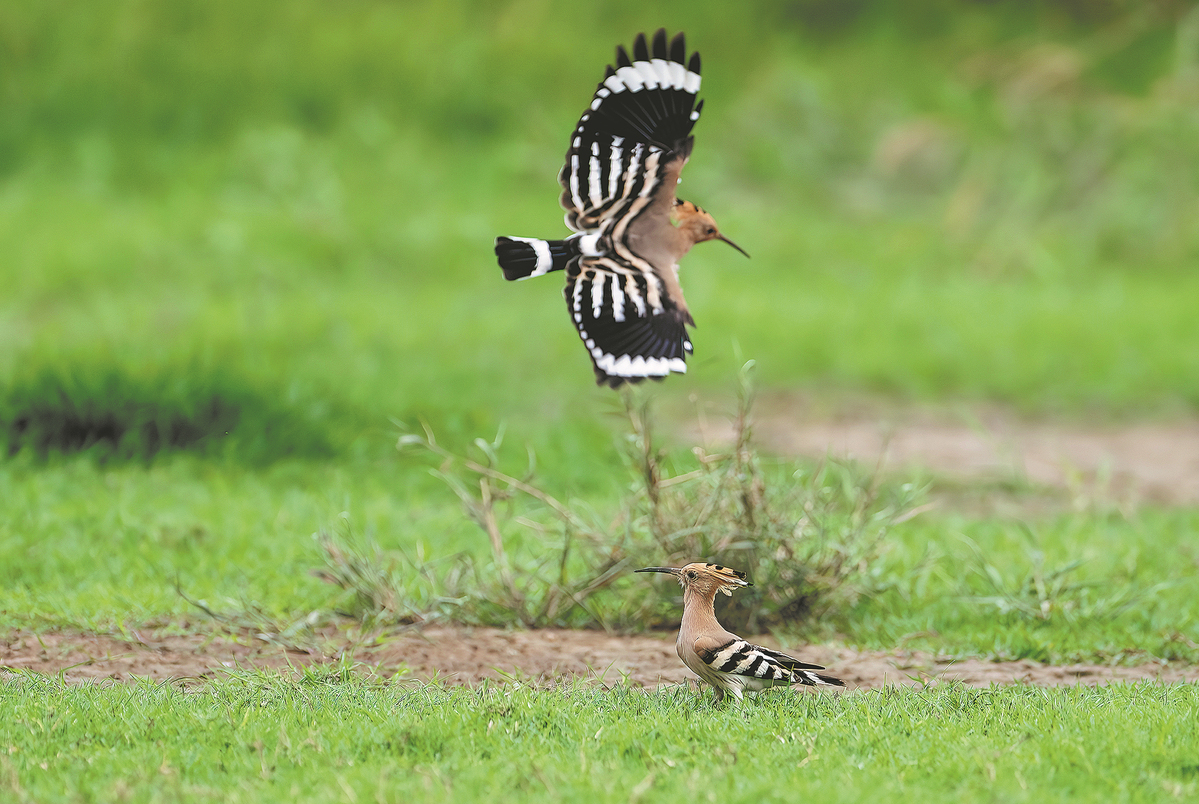Climate change poses huge challenge to avian migration
Avian migration is a challenging journey that is subject to sudden storms, vast bodies of water and the risk of losing direction.
Climate change has made this situation worse, especially with record-low temperatures in northern China this winter.
In early November, a snowstorm struck more than 100 Oriental white storks in Changchun, the capital of Northeast China's Jilin Province, during their southward migration. The birds are classified as first-level protected animals in China.
As the storm passed, most of the storks continued their journey, except for 11 birds who were too exhausted to fly on.
On Nov 16, staff members from the local forestry and grassland bureau transported these birds to the Qilihai wetland in Tianjin, where they joined others migrating to the area. The 11 storks are in good condition in their natural habitat, the bureau said.
Oriental white storks usually leave their breeding grounds in Northeast China for the warmer south in September or October, returning north in spring.
By Nov 24, about half the migratory birds in China had completed their journeys and reached coastal areas in eastern and southern parts of the country for the winter, the National Forestry and Grassland Administration said.
At that time, cranes and storks were experiencing a second migratory peak, the administration added.
The China Meteorological Administration said the increasing frequency of extreme weather events, rising sea levels, disappearing wetlands, and record temperatures are having adverse effects on avian migration.
Severe drought, wind and temperature drops, and wildfires that force birds to alter their routes are contributing to migratory difficulties.
Without the ability to replenish their energy and rest in areas along their route, birds may struggle to reach their habitats safely, the administration said.
In late summer 2020, wildfires and an early snowstorm are thought to have played a major role in causing a huge number of deaths among migratory birds throughout the west of the United States.
An essay published in the journal Geo-Health in 2021 said a laboratory report showed that the birds were severely emaciated.

Hoopoes arrive to spend winter in Fuzhou, Fujian Province. WEI PEIQUAN/XINHUA
Severe drought
In 2022, Poyang Lake in Jiangxi Province, China's largest freshwater lake, experienced a prolonged drought and food shortages that jeopardized the wintering grounds of numerous waterfowl species, including swans, geese and ducks. That year, the lake entered its dry season 100 days earlier than when records were first taken in 1951, setting a historically low water level.
The drought, a rare occurrence during the summer, had devastating effects on submerged vegetation, which is essential for wintering waterfowl.
Jin Jiefeng, a Yangtze River program director at the International Crane Foundation, told China Dialogue Ocean that although they may not necessarily alter the migratory routes of the birds, changes in the timing of migration due to insufficient food supplies could impact their breeding cycles and overall population development.
China Dialogue Ocean is a platform dedicated to highlighting, analyzing and helping to resolve the ocean crisis.
A study by US researchers published in the journal Nature Climate Change in 2019 suggested that compared to 20 years ago, migratory birds are passing certain sites earlier in spring, possibly due to rising temperatures. In spring and autumn, warmer seasons indicate earlier peak migration dates.
Not only has the timing of migration altered, but due to factors such as climate change, so too has the distribution range of some avian species.
Jia Yifei, associate professor at Beijing Forestry University's School of Ecology and Nature Conservation, said winter habitats have expanded northward, as more migratory birds such as red-crowned cranes spend this season in Shandong Province, which is further north than Jiangsu Province, a traditional winter habitat for the species.
The Yellow River Delta, a vital wetland for migratory birds, has seen a rise in the number of winter arrivals.
Since 2020, the number of avian species at the delta's nature reserve has risen from 187 to 373. A total of 389 red-crowned cranes were sighted at the reserve in January last year, up from 306 in January 2022.
Jia said: "The increasing frequency of extreme weather events globally due to climate change affects migratory routes and habitats. However, climate change is just one of the factors, and it is hard to gauge how much climate affects avian migration."
In 2021, Chinese researchers wrote in an essay published in the journal Ecological Indicators that migratory birds will change their habitats and growth cycle in response to climate change. The direction and distance flown are different for every species.
Delicate balance
Over the past century, sightings of the rainbow-hued ibis were extremely rare in China. However, in recent decades, the birds have been consistently reported in a vast area of the country, ranging from the Inner Mongolia Autonomous Region in the north to southern parts of Yunnan Province in the south, the China Meteorological Administration said.
Jia said avian species are trying to adapt to human-dominated environments, adding that the delicate balance between human activities and conservation efforts determines the fate of bird populations.
"Migratory birds are smarter than we thought. Some can adapt to climate change well. For example, cranes, which have good migration capabilities, often live for more than 20 years. The fact that they live longer than other birds contributes to their wealth of field experience and resilience in adverse conditions," he said.
While efforts to mitigate global warming are crucial, Jia said the focus remains on adapting to the inevitable changes and providing sufficient habitats for migratory species to thrive.
He added that as birds migrate globally, a consensus on offering them sufficient habitats is needed in the international community.
"Humans and other creatures share the global ecosystem as biodiversity. This plays a pivotal role in supporting various aspects of life," Jia said.
"Ensuring the preservation of biodiversity is not just an ecological imperative, but also contributes to the well-being of cultures and the fundamental functioning of the planet."
In November 2022, during the 14th Meeting of the Conference of the Contracting Parties to the Ramsar Convention on Wetlands, held in Wuhan, Hubei Province, a China Bird Migration Channel Protection Network Initiative was announced. The initiative called for priority to be given to protecting wetlands on avian migration routes.
The Chinese Academy of Forestry said China is one of the world's most biodiverse countries, hosting 1,445 avian species, or about 17 percent of the global total. Among them, more than 800 species exhibit migratory behavior, underlining the nation's crucial role in global bird ecology.
Four of the nine major bird migration routes in the world pass through China. To protect them, the nation has built more than 2,200 wetland nature reserves and numerous wetland conservation communities, the National Forestry and Grassland Administration said.
Meanwhile, the International Crane Foundation has worked with Chinese nature reserves and scientists to maintain water and vegetation in four key wetlands on the Songnen Plain, which is situated between Heilongjiang and Jilin provinces.
This work was reported by Rich Beilfuss, the foundation's president, in an article titled "A Risky Climate for Cranes, Wetlands and Our World", which was published in 2018.
Jia, from Beijing Forestry University, added: "We have a long way to go to properly manage the ecosystem. For example, in addressing the issue of drought in bird habitats, authorities are trying to find a middle ground that both safeguards the ecological system and sustains economic benefits, as it is difficult to assess the outcome of ecological gains."
Photos
Related Stories
- Chinese, Brazilian scientists name new flying reptiles to mark collaboration
- Goitered gazelles spotted in Xinjiang
- China releases the first list of 789 important habitats for terrestrial wildlife animals to strengthen protection
- China actively tackles climate change at home and abroad
- Study reveals marsh wetlands' response to climate change in Qinghai-Tibetan Plateau
- Wild Mongolian gazelles migrate
Copyright © 2024 People's Daily Online. All Rights Reserved.









